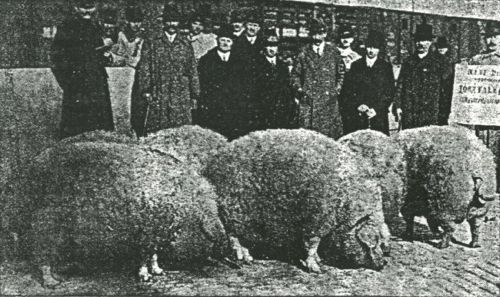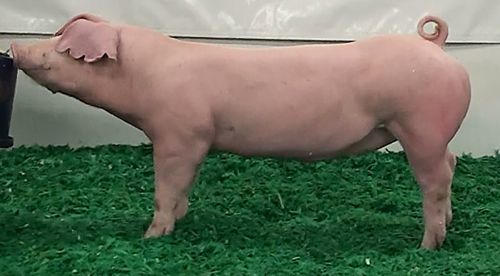Good Lard is Where You Find It
There’s a lot of lard on the average hog, though admittedly not nearly as much as there used to be. Demand for leaner and leaner pork over the years has yielded pigs with less fat on them than your typical high-fashion runway model.
In days gone by pigs were divided into two main classifications: lard pigs and bacon pigs. They still are, really, but it hardly needs to be emphasized that lard pigs aren’t much in demand anymore. When they were, the king of lard pigs was the Mangalitsa, a Hungarian breed that packs on more fat than Oprah on a month-long cookie dough bender. Just look at these beautiful little curly-haired balls of blubber:

Now, before you say Yuck! Horrible factory force feeding! I’d like to point out that this picture was taken well before there was such a thing as a factory farm. It actually takes quite a bit of time for a hog to put on this much weight. Lard pigs are naturally small, short-legged, stocky grazers. Compared to modern meat-type pigs like the long, sleek and muscular Landrace below, they grow slower, consume more food, have smaller litters and have generally less muscle. Thus they’re a lot less economical for a typical pig farmer to maintain.

The upside is that lard pigs produce meat and fat of a very special quality. Here I should insert that while fat can be found all over a pig, the main deposits are on the back, between the flesh and the skin (high-grade hard fat used for “fat back”, salt pork and Italian lardo), amid the organs (low-grade soft fat historically used as cooking fat) and in the so-called flare region, the area around the loin near the kidneys. This is where the high-grade medium-soft fat — “leaf lard” — comes from, and for bakers, it’s where the money is.
If you recall previous discussions of fat, you know that firmer fat tends to be higher in saturated fat molecules. Saturated fats are generally thought to be less healthy for people to eat (though as we’ve been discussing, all that convention wisdom is being called into question these days). Firmer fats also don’t melt as readily as softer fats. So there’s good reason for bakers to prefer the softer leaf lard over harder lard from the back of the pig — it performs quite like another semi-firm fat that bakers get excited about: butter. Here I should point out that even the back fat from a lard pig is softer and lighter than that of a meat pig. Leaner meat pigs tend to have firmer, more highly saturated fat all over their bodies, lard pigs, softer. The meat of lard pigs — though they have a good deal less of it — is also better marbled and juicier.
So you can see there are a lot of good reasons to have lard pigs around. So why don’t we? If you were about to say Procter & Gamble and money-grubbing corporate factory farmers! let me remind you that it’s been the health and fitness community that’s both demonized lard and pressured producers for leaner and leaner pork over these last sixty or seventy years. So there’s plenty of blame to slather around.
However the good news is that there are probably more lard pigs trotting about now than there have been in ages, as farmers (especially small farmers) find markets for the sorts of meat products lard pigs produce. Who knows? The Mangalitsas, Guineas and Mulefoots might be poised for a dramatic comeback as more people start realizing the virtue of solid animal fats. If you’re interested, start asking around at farmers markets where the small producers are. Who knows what you might find? Maybe some really excellent lard.
My older relatives always mourn the way cherished pork recipes just don’t taste the same anymore, which we had been attributing to the breeding for leaner pork.
So I was wondering if that had any affect on the lard available today. And there is your post answering my questions before they are even fully formed!
Hehe…happy to help, Cath! 😉
– Joe
Living out in farm country has its advantages – I discovered last weekend that there’s a place called the “Hartland Abattoir” a couple towns over from where I live. It appears to be a small slaughterhouse that also sells meat retail – as soon as I have some free time, I’m going to have to stop in and have a long talk with them about such things as lard, odd cuts of meat, and perhaps fresh skins for tawing…
Wow! Lucky you. I need to find a resource like that around Louisville…there must be something. I’m out of leaf lard and really need some for a couple of projects I’m planning.
Cheerio,
– Joe
In addition to breeding for less fat the drive on the farm is for faster growth. That means more corn and soybeans for feed which produces less flavorful meat, just like it does with beef cattle.
Lets just skip what they are doing with antibiotics and other things that are not good for man nor pig.
Very interesting, and makes a lot of sense. Lard pigs definitely took more time to raise, which I’m sure made them less economical as well. Thanks Frankly!
– Joe
Joe, speaking of being out of lard, the little I have left has been in the frig for a month or more. And it now has developed a few little green spots — which I assume is mold. It smells the same, and I’m tempted to just pick out those spots, but that’s probably not wise. Should I just dump it?
Hey Jim! My gut says it’s probably nothing to worry about but as grandma used to say: when in doubt throw it out. Good advice I think. It’s probably not much good for baking anyway by now…dump it and get something fresh!
Cheers,
– Joe
I scored some Mangalitsa lard once. A 5-gallon pail (I kid you not) mail-ordered from a butcher in Seattle (or maybe Portland). Mmmmm good! I used it for biscuits, fried eggs, refried beans, and fried potatoes. Worth every penny of the $24 I spent on it.
I also roasted a goose once, and kept all the fat. It made heavenly fried potatoes. And I couldn’t believe the amount of fat that bird gave up. I was not a huge fan of roasted goose, but the fat was even better than lard.
Holy cow! I mean pig! I mean LARD pig!
Five gallons for 25 bucks? Is that butcher still around because that’s a dream come true for me. Regarding goose, I’m with you. The fat is where the money is. Roast goose meat isn’t terribly exciting, but goose fat fries are tha bomb.
I’m quite jealous actually. 😉
– Joe